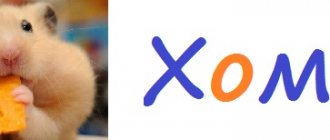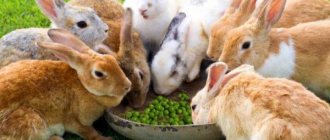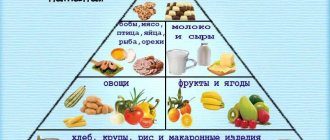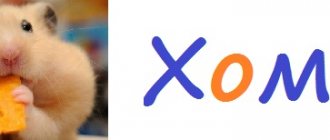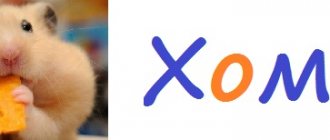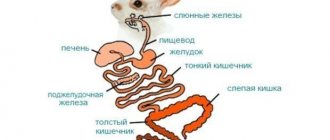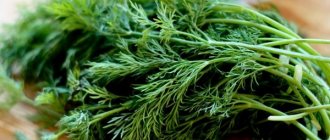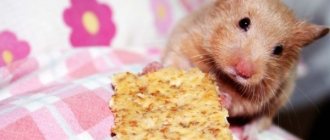The benefits of vegetables in the diet
A proper diet for a guinea pig includes foods rich in vitamins and microelements. Grain feed does not contain enough of these components, so additional nutrition consisting of fresh vegetables is required.
The daily requirement of vitamin C for guinea pigs is from 10 mg to 20 mg. The microelement helps improve the immune system and normalize the functioning of organs of all systems. An adult requires no more than 15 mg, a pregnant and lactating female - 20 mg. An excess of vitamin C leads to the development of dermatological diseases and kidney dysfunction.
Vegetables are a source of calcium and phosphorus, which are necessary for the normal development of your pet. However, exceeding the permissible level of indicators leads to the formation of urolithiasis.
Other products
Can guinea pigs eat bread? It's better not to give.
- Fresh yeast bread takes a long time to digest and causes fermentation in the animal’s stomach.
- White bread causes bloating.
- Your pet can eat stale bread, but not often.
- Dried bread with seeds, sesame seeds and raisins can sometimes be offered to your pet as a treat.
Can guinea pigs eat nuts and seeds?
Nuts and seeds are among the allowed foods, but can cause obesity if their consumption is not limited. It is better to offer your pet almonds, walnuts or hazelnuts.
What vegetables can you give?
In order for succulent food to benefit your guinea pig, you need to familiarize yourself with the list of permitted vegetables. These foods contain large amounts of vitamins and minerals.
Zucchini
Introducing young zucchini fruits into your guinea pig's diet will bring great benefits to your pet. The vegetable contains a large amount of vitamins, minerals, and fiber. The composition contains sugars that do not exceed the permissible limit.
Carrot
The root vegetable is considered the main source of beneficial microelements. It includes:
- vitamin C;
- vitamin K;
- B vitamins;
- vitamin E;
- pectin;
- carotene.
Nutrients help improve metabolism, maintain normal vision and hearing. Microelements have a positive effect on the condition of the skin and coat. You can feed your guinea pig not only root vegetables, but also tops containing vitamins and minerals.
If carrots make up the majority of the diet, your guinea pig's urine will turn bright orange.
White cabbage
The vegetable is on the list of permitted ones, but it can only be fed to absolutely healthy pets. If the animal is prone to developing diseases of the gastrointestinal tract, eating cabbage can cause flatulence and diarrhea.
The product is introduced into the diet in small portions so that the rodent gradually gets used to it. If you feed a large amount of cabbage at once, health problems cannot be avoided. In addition to white cabbage, you can give small amounts of Brussels sprouts, kohlrabi and broccoli.
cucumbers
The vegetable consists of 95% water. The rest of the composition is occupied by:
- proteins;
- cellulose;
- Sahara;
- vitamins and minerals.
Cucumbers are not considered a nutritious food, but they have a positive effect on digestion. Overfeeding a rodent with vegetables increases the risk of developing digestive disorders. A small amount of the product is allowed for consumption.
Pumpkin
Pumpkin is considered a healthy vegetable, which includes:
- cellulose;
- proteins;
- vitamins;
- Sahara;
- useful micro- and macroelements.
Not only the pulp is included in the diet, but also the peel and seeds. Pumpkin helps normalize the gastrointestinal tract. Pumpkin seeds are given as a preventive measure against helminths.
Melon
It is permissible to introduce melon into the diet only at the height of the season. A small amount of ripe flesh is cut off from the guinea pig at a distance of at least 2 cm from the peel, since the largest amount of nitrates is concentrated near it.
You should not give melon to your guinea pig too often. The fruit contains a large amount of sugars that can lead to the development of diabetes in your pet.
Tomatoes
Includes:
- vitamin A;
- pectin;
- organic acids;
- vitamin C;
- micro- and macroelements.
Only ripe tomato pulp is introduced into the guinea pig's diet, since the unripe vegetable contains solanine. A high concentration of this substance can lead to the death of a pet. It is strictly forbidden to feed your guinea pig leaves. A large amount of tomatoes in the diet can lead to diarrhea.
Beet
The root vegetable is considered one of the healthiest for guinea pigs. Despite the benefits, beets are given in small portions, as they have a laxative effect. An excess of root vegetables leads to the development of diarrhea.
Beets are excluded from the diet of pregnant and lactating guinea pigs, as well as children under two months of age. The tops are of particular value. The pet eats it with pleasure. If you frequently feed beets, your urine may turn red.
Green pea
Feeding only fresh fruits is allowed. Introducing it into the diet together with pods is acceptable. Peas contain a large number of useful micro and macroelements and vitamins. Feeding in small quantities is allowed, as an excess of product will lead to bloating.
Jerusalem artichoke
The composition of the root vegetable includes:
- cellulose;
- lysine;
- arginine;
- leucine
It is allowed to feed guinea pigs with Jerusalem artichoke in small quantities, since the fruit contains starch, which is dangerous for animals. The diet includes root vegetables, as well as leaves and stems.
Celery
It is allowed to feed the guinea pig celery root, stems and leaves. Regular consumption of celery helps improve the functioning of the gastrointestinal tract.
bell pepper
The vegetable contains a large amount of carotene and vitamin C. Microelements are necessary for the normal functioning of the pet’s organs and strengthening the immune system. The rodent is given bell pepper in pieces, after removing the stem and seeds.
You can feed your guinea pig bell pepper during the ripening season; during the cold season, the vegetable contains a large amount of nitrates.
Meal order
As a rule, adult rodents of this family are fed up to 3 times a day. One meal contains up to 2 tablespoons of combined food. When feeding 2 times a day, you need to pour 3 tablespoons into the feeder at one time. The food container must be systematically located in the area designated for the rodent; under no circumstances should it be removed. If the animal does not start eating at the same hour, it will certainly have lunch later.
The territory of the animal's home must certainly be covered with hay, and in the summer - grass. The use of hay helps with grinding teeth and has a positive effect on digestive processes. The use of grass is the richest source of vitamin elements.
The purified liquid will also be continuously available in your pet’s home. If the animal consumes food, then during breaks it will snack on hay. At the same time, if you leave your baby hungry, this will have a negative impact on his immune system.
Rules for feeding vegetables
Basic rules for feeding vegetables to guinea pigs:
- Only fresh products are allowed for consumption. If the pet doesn't finish eating, the leftovers are thrown away.
- Vegetables, especially root vegetables, are thoroughly washed. There should be no dirt left on the peel.
- Lettuce and cabbage should be washed and dried before eating.
- The most useful vegetables are those collected from your own garden.
If you follow simple rules, your guinea pig will be in good health and in a good mood.
Specific nutritional features
When purchasing food for your pet, you need to pay attention to the quality level of the elements contained in it. To do this, you must know exactly the answers to questions such as whether this or that food has a good taste and color, whether it contains harmful elements, etc.
New food must be introduced into the rodent's diet in parts, starting with small portions. During the addition, it is worth looking at the condition of the guinea pig.
If your pet often overeats, this will lead to acute disorders of the digestive system. The process carries with it dangerous and long-lasting consequences, obesity and a number of related diseases. There is no need to feed the animal every hour, when it first squeaks or rises on its hind legs. This behavior may indicate that he has nothing to do. Sometimes, it is quite enough to just play with the animal or allow it to run around a wider area.
Experts in breeding guinea pigs recommend eating wheat bran, oats, carrots, beets, good hay as the best food; in the summer, replacing root vegetables and hay with freshly cut grass. The bran must be soaked in water or boiled milk.
What vegetables should you not give?
There is a list of prohibited vegetables, the consumption of which negatively affects the health of a guinea pig.
Radish
Breeders are categorically against the introduction of radishes into the diet. The root vegetable contains a large amount of essential oils, an excess of which leads to flatulence and irritation of the mucous membranes. You can only feed your guinea pig radish tops.
Corn
It is not advisable to feed corn to guinea pigs. This is due to the high content of starch, which is not digested in the pet’s gastrointestinal tract. In addition, the vegetable contains a large amount of sugar, which provokes the development of diabetes.
You can also feed your pet foliage and corn stalks.
Cauliflower
Breeders recommend excluding the vegetable from the rodent's diet. Cauliflower causes bloating and constipation.
Radish
The root vegetable contains a large amount of essential oils that cause irritation of the mucous membranes. Vegetables are excluded from the pet’s diet. It is allowed to give guinea pigs only radish tops.
Potato
Despite the high content of vitamins and proteins, the root vegetable is not recommended for inclusion in a rodent’s diet. This is due to the high content of starch, which leads to disruption of the gastrointestinal tract. Tops and greened tubers are harmful to the health of guinea pigs due to their high solanine content.
Before introducing natural plant foods into your guinea pig's diet, you need to find out which vegetables can be given to your pet and which are undesirable. Some fruits contain substances that disrupt the functioning of internal organs.
Indoor flowers
During walks outside the cage, the animals sometimes gnaw on some indoor plants. This must be stopped immediately because most domestic plants are poisonous to pigs. It is better if the pots are located in places inaccessible to rodents.
The most popular indoor plants that are dangerous for pigs:
We suggest you read: What smell repels cats so they don’t shit
Palm trees and cacti should also be kept away from a curious pet.
How to determine the norm
Eared animals eat this vegetable willingly. Is it possible to give cabbage to rabbits daily? It is possible, but in small quantities, otherwise the animals will stop eating other food, as a result of which the intestinal microflora will be disrupted and the active form of flatulence will develop. Rabbits should be given slightly withered leaves, but stalks should be discarded, as they negatively affect the development of young animals and provoke diseases.
Rabbits are allowed to feed cabbage according to the following scheme per animal:
- young individuals: in winter 100-200 g, in summer - 300 g;
- sexually mature individuals: in winter 300-400 g, in summer - 500-600 g.
Pets often experience an upset stomach after eating the white cabbage variety.
In this case, it is important to review the main menu of Ushastik. It may be necessary to balance such a vegetable by increasing dry food.
Additional feed
Supplementary food does not mean it is of secondary importance in the diet. It just varies depending on the season and is interchangeable.
Green food
In summer, green food plays a very important role.
Useful herbs
Your guinea pig will benefit from: dandelion leaves, plantain lanceolate and greater, yarrow, nettle (young leaves), carrot tops, white and meadow clover, chickweed, alfalfa, heather, sedge (young), burdock, sow thistle, hogweed, wheatgrass , sage, field sow thistle, oats, peas, sweet clover, winter rye.
In limited quantities, your pet can be given tarragon, wormwood, parsley, and dill.
In spring, grasses (especially clover and alfalfa) are rich in protein, but poor in fiber, and therefore they are given in limited quantities.
In the spring-summer period, collecting herbs will not be difficult, unlike in winter, when the solution may be to independently grow herbs on the windowsill. Or, what’s even simpler, buy ready-made special grass grown for cats at a pet store.
You cannot collect herbs near highways and highways, in the yard, in dog walking areas, or near fields that are treated with special pest control products.
Other
Among other things, it is worth mentioning that guinea pigs do not tolerate processed foods: fried, boiled, pickled, baked, canned. The owner must not feed the pet food from his table. Including sweets: chocolate, marshmallows, cookies, etc.
Other prohibited products include:
- mushrooms;
- sauces - ketchup, mustard, etc.;
- sorrel;
- plantain.
There are special sweets for rodents - drops. They come in different flavors - berry, citrus, vegetable. Pets really like them, they should be used carefully and offered occasionally, like regular fruits. Drops contain sugar, which is harmful to animals.
Before offering your pet something tasty, you should check the list of prohibited foods. If there is no information on a specific product, the best option is to put it aside and choose something else.
Chinese cabbage or Chinese salad.
Chinese cabbage or Chinese salad. ¶
From: Tigrena - November 14, 2003 1:02 am
Hi! glad_vstr People-and-and, help me figure it out! I pray_n In stores they sell a certain greenery called “Chinese cabbage”; in the market the same thing is called Chinese lettuce. :confused: I'm interested in the fact that it's 1) cabbage or lettuce, 2) can it be given as a salad without limiting the quantity, 3) if it's cabbage, then the dosage of this product is limited, do I understand correctly? 4) Who feeds this to their animals? Thanks everyone for the answers! [13 November 2003, 16:04: Message changed: Tigrena]
Chinese cabbage or Chinese salad. ¶
From: Mr. Wolf - November 14, 2003 1:21 am
It's actually head lettuce, aka Chinese cabbage! Judging by its taste, it is something between cabbage and lettuce, although it looks more like lettuce
in general, it seems to me that if you don’t get too carried away with it, then you can feed it, I feed it, let’s smoke?
Chinese cabbage or Chinese salad. ¶
From: Tolka - November 14, 2003 1:37
Mine eat it and love it more than white cabbage.
Chinese cabbage or Chinese salad. ¶
From: Mahnurka - November 14, 2003 2:02 am
Hi Hi! I give my pig Chinese salad in winter instead of cucumbers, 2-3 leaves. the pig loves him very much
Chinese cabbage or Chinese salad. ¶
From: 84550 - November 14, 2003 2:10
But mine only love the green part of the leaves of this salad, and don’t really like the harder white part. But my dog loves soup made from this white part. This is the waste-free consumption of the Chinese plant! laughter
Chinese cabbage or Chinese salad. ¶
From: shitokai - November 14, 2003 4:16 am
Actually, as correctly noted above by Mr. Wolf, this is definitely a salad. Our old pig simply adored it and instead of cabbage and cucumbers he just gobbled it up and gobbled it up quite a lot and everything was fine with him, we even bought this salad especially for him
Chinese cabbage or Chinese salad. ¶
From: Anya - November 14, 2003 5:12 am
about the Chinese cabbage - I don’t know, it’s embarrassing, but I buy Chinese salad for my pig, but the truth is, my pig loves ordinary salad more
Chinese cabbage or Chinese salad. ¶
From: Maria Krivtsova - November 14, 2003 17:49
We love him too, especially the “tops”, i.e. the leaves themselves.
Chinese cabbage or Chinese salad. ¶
From: Leo - November 15, 2003 3:15 am
This plant just doesn’t have many names. Actually, Beijing cabbage would be correct. Those. in literature it is like that. Although in terms of taste, it is more of a salad. It is not suitable for cooking; it is used only either fresh or specially fermented. (In Korean cuisine - chimcha (kimchi)). So, we start from the salad and eat immeasurably.
Still, we polish it with hay later, just in case. In general, I have made it a rule that I polish various juicy delicacies with hay and granulated feed.
Source
Results
In moderate doses, fresh grass can be added to the daily diet of guinea pigs. But before you offer your pet fresh grass, be sure to check out what properties it has and whether your pig can eat this particular type of green food.
Did you like the article? Share with friends: [supsystic-social-sharing >
- Related Posts
- Diagnosis, symptoms and treatment of worms in guinea pigs
- Guinea pig colors
- Guinea pig allergy
Fruits and berries
Can guinea pigs have bananas? A banana rich in potassium will benefit your guinea pig, but you should not give more than 1 piece per day.
The peel of the vegetable must be removed, as it is treated with substances hazardous to health (wax, chemicals, ethylene and pesticides). For safety, it is better to remove soft fibers from the fruit.
Can guinea pigs eat a pear?
Pears can be given with the peel, but without the seeds. The fruit is washed well and cut into pieces; the pig should be offered water along with it. Excessive consumption of pears due to their high sugar content can cause diarrhea.
Can guinea pigs eat kiwi?
Kiwi is a very healthy fruit for animals. It contains a large amount of ascorbic and folic acids. It is also rich in vitamins E, iron, calcium, magnesium and phosphorus.
Kiwi is given without skin in the form of small pieces. For your pet, you need to choose harder fruits. It is better to control the amount you eat. An increase in the dose of kiwi is permissible in autumn and winter, as well as when feeding females during pregnancy and lactation.
Can guinea pigs have oranges and other citrus fruits?
Can be used occasionally. But it is better for guinea pigs to get vitamin C from other foods, avoiding citrus fruits. Possible complications:
- oversaturation with vitamins; skin irritation; oxidation of urine.
Can guinea pigs eat apples?
Apples can be raw or dried. They have a balanced ratio of sugar and fructose (18:80%). It allows the pig to be active.
The fruit must be peeled and cut into slices. It is better not to give more than 3 pieces at a time.
Can guinea pigs eat strawberries, grapes and other berries?
Strawberries contain a sufficient amount of vitamin C to pay attention to the berry when choosing a treat for a rodent. You can also give strawberry leaves to animals.
- The pig might like grapes. You can offer the animal seedless grapes. Eating currants once a week will also not harm your pet. If you do not abuse it, you can offer the pig berries and raspberry leaves, berries, leaves and branches of blueberries, blackberries and sea buckthorn, and rose hips without seeds. Cranberries are given for medicinal purposes. It has an anti-inflammatory effect on the mucous membranes of the mouth, stomach, and bladder.
Soft bag
Fabric carriers have been around for a long time, but their modern development has primarily affected the increase in the number of all kinds of windows, mesh and other little things. The cat will no longer sit in a dark bag, not much different from an ordinary travel bag. It is difficult to organize a comfortable long trip in such a device. But for short distances the convenience is quite adequate.
The advantage of a soft cage is its lightness, compactness, and the ability to securely attach it to a car seat or, for example, to the handle of a suitcase.
Negatives: Not hygienic for long trips and difficult to clean quickly (although they can withstand washing in a regular washing machine).
Cost – 1,360 – 1,489 rubles.
